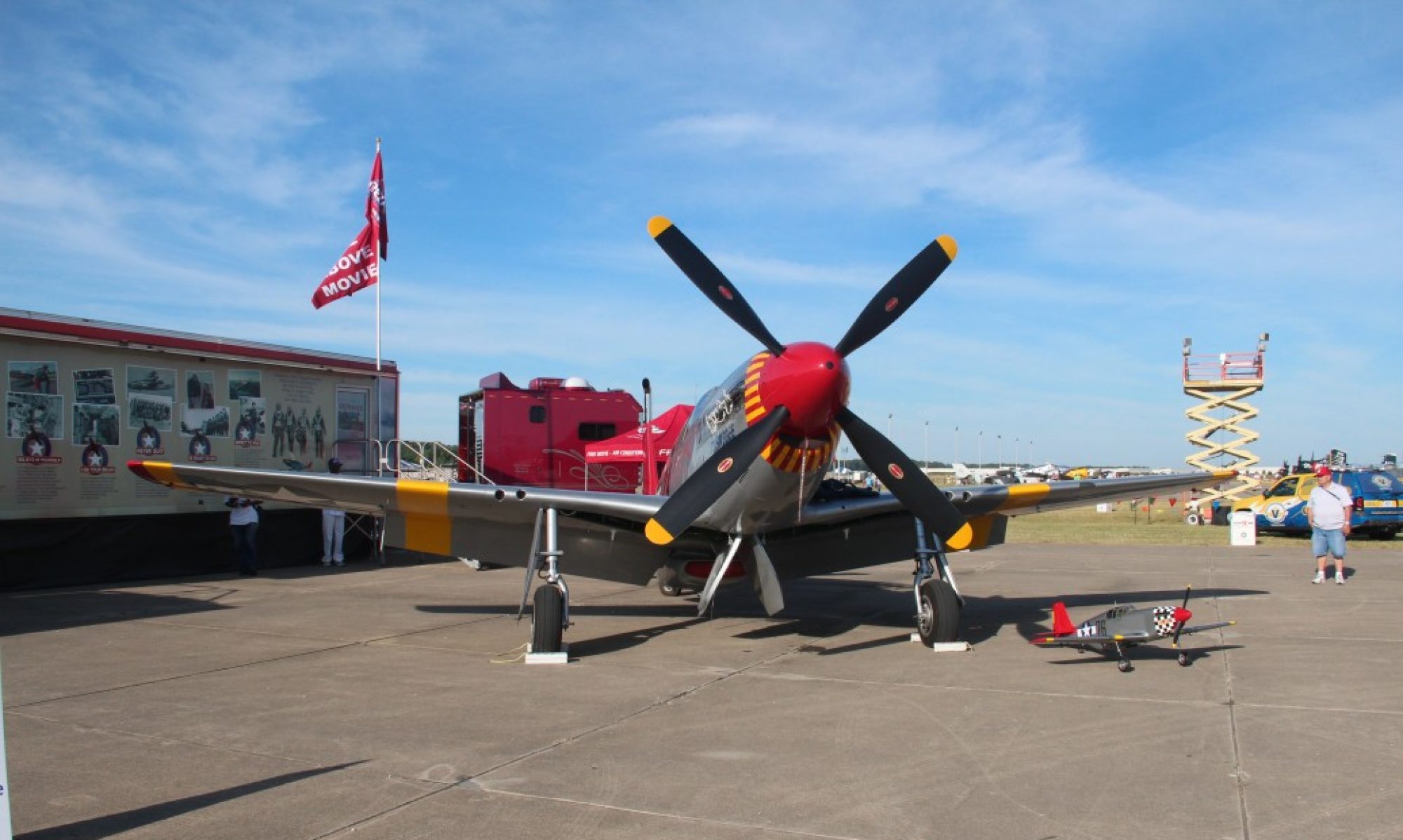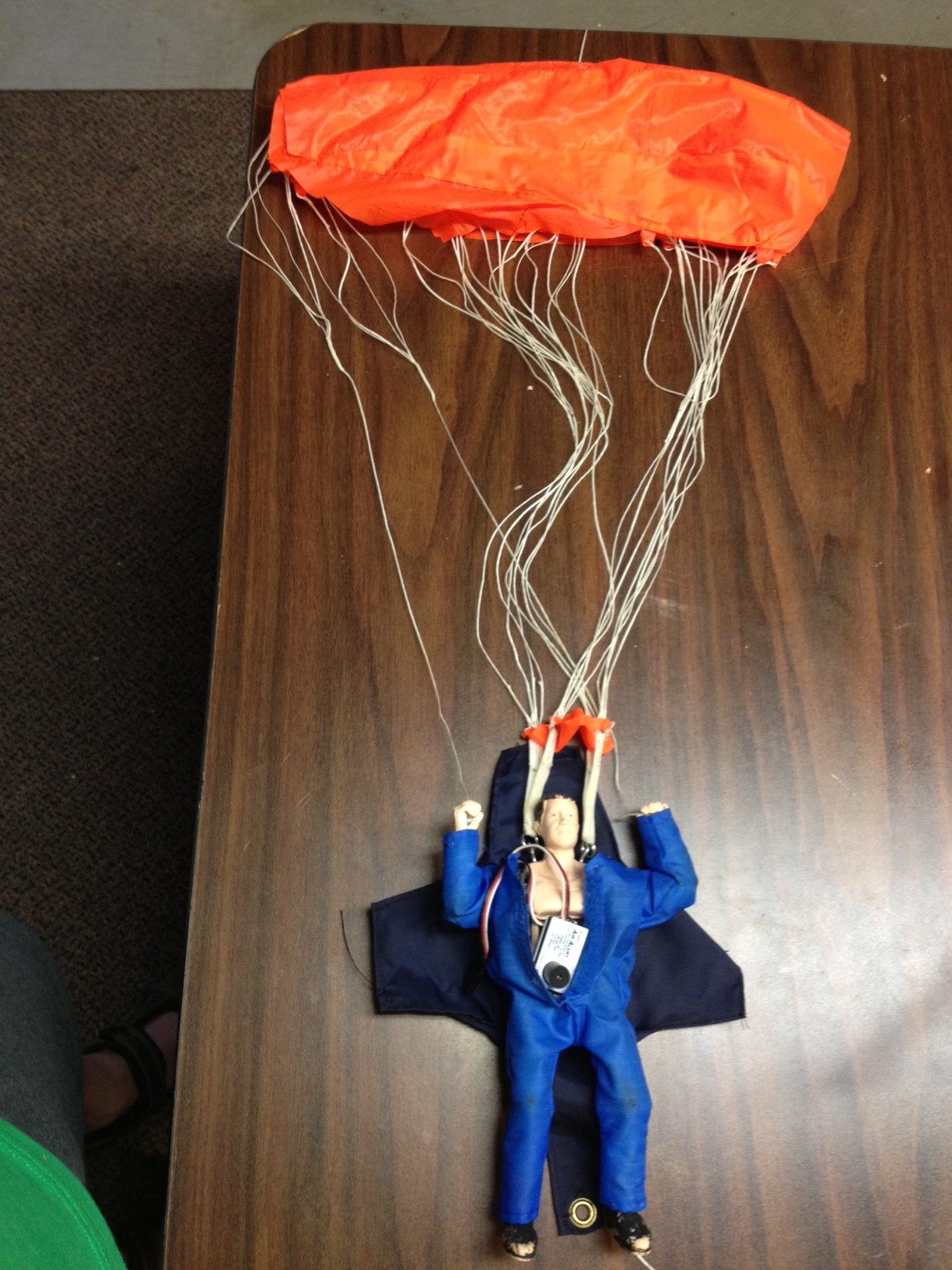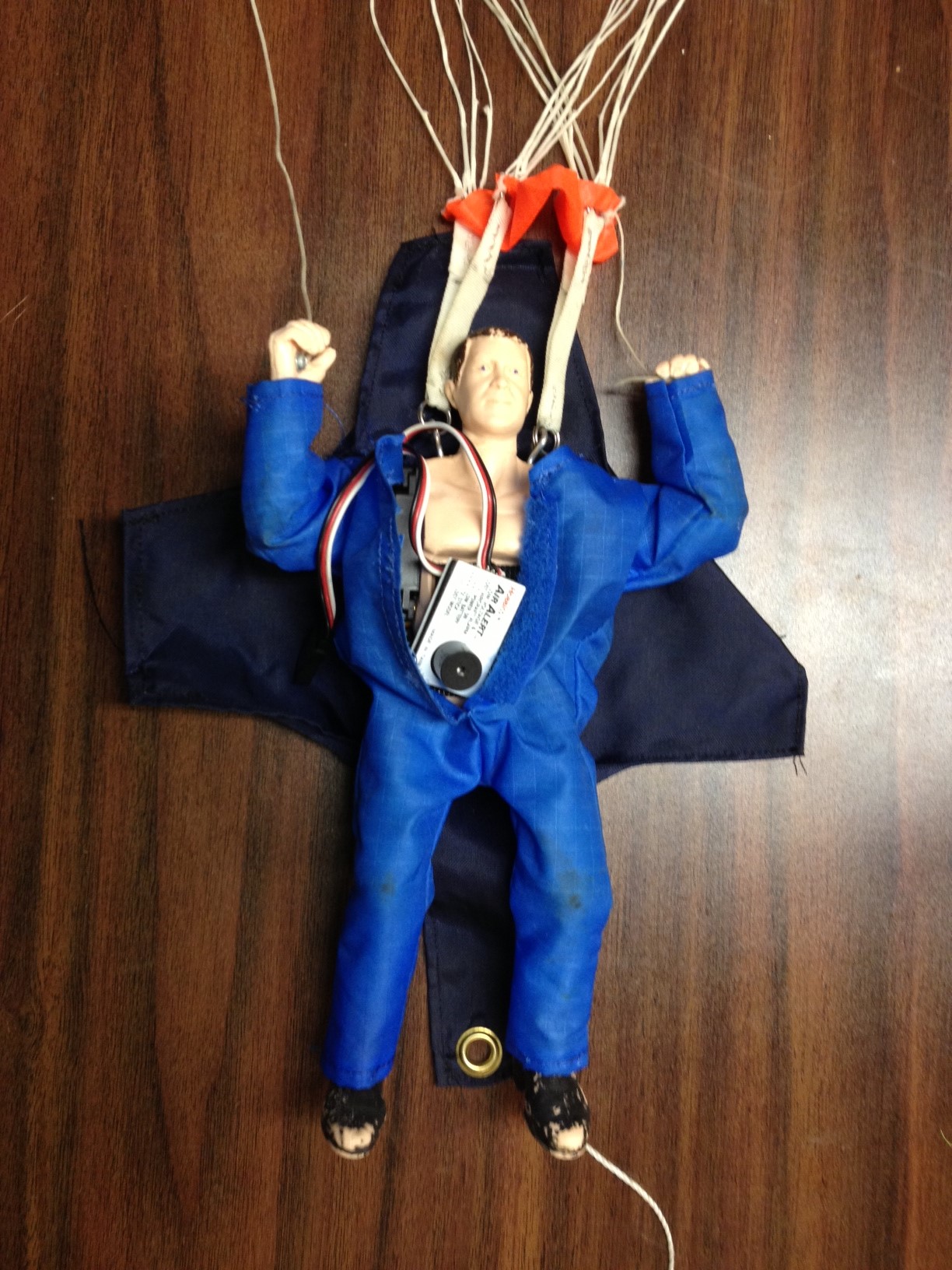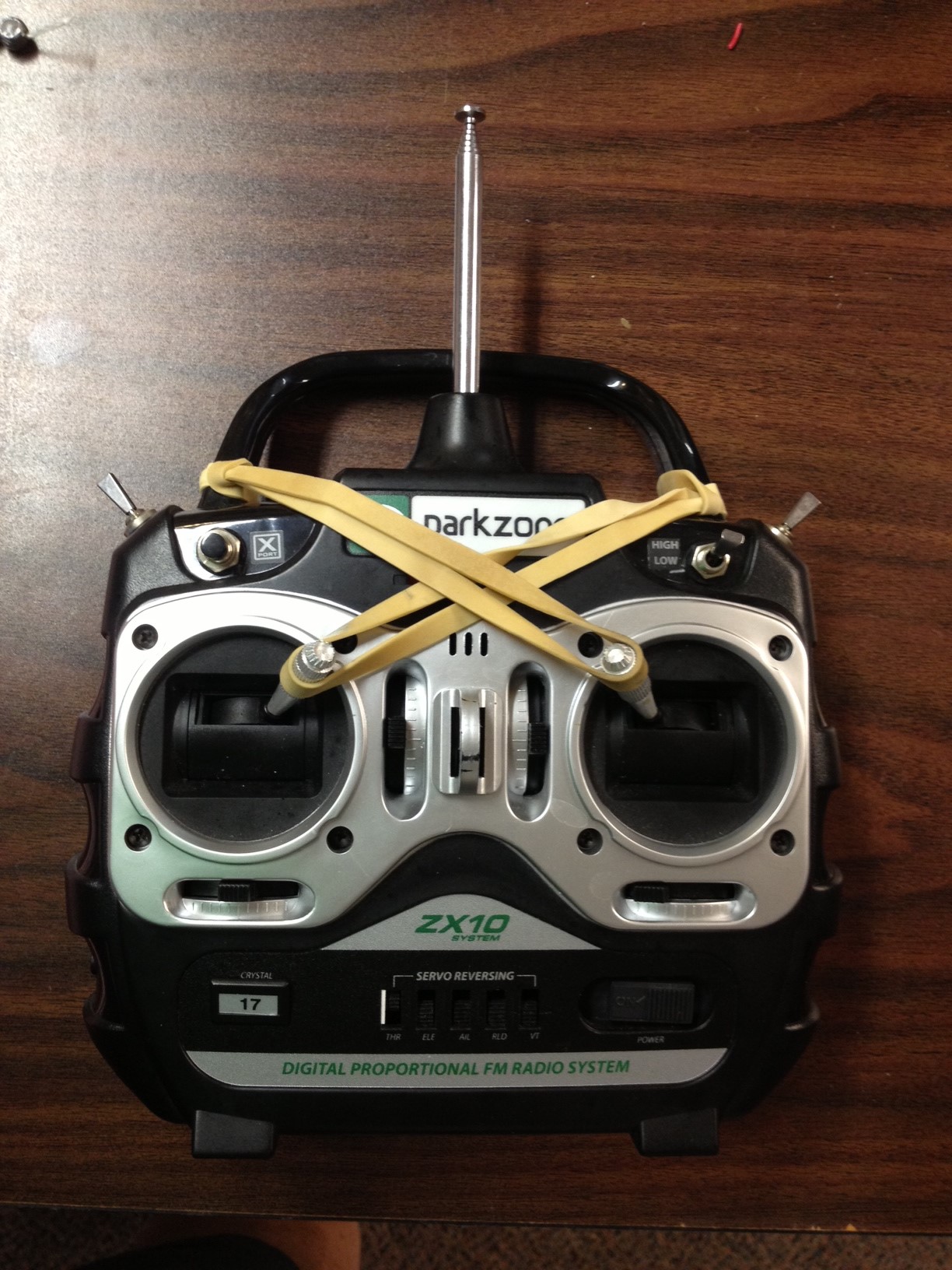I just added a new document to the my Articles page discussing ways to extend the life of your LiPo batteries. Hope you enjoy it.
More P5-1 flights and Skydiver has problems…
Three more flights today on the P-51 today. I think they were number 10-12 on this bird. She flies well with adequate power from the DA-50 and with full flaps the landings are getting to be smoother all the time. No appreciable bounces today and 2 landings that were totally greased in. I may have to start saving to modify the retracts to electric power and consider installing them if I keep this up! The Top Flite is a really nice flying model. Once you get the flaps dialed in with a little up elevator mix on deployment it isn’t too bad to land.
On the skydiver front, George had a bad day. After a successful early jump, the next two were ugly. First, the release mechanism didn’t and he stayed firmly attached and then on the next attempt he did a “hanger” and simply drug along behind all tangled up and just to add injury to insult his arm busted off when I landed… 🙁
He has already been repaired and is ready for the next attempt. Also had a scare with misplacing his “static line” that attaches to the plane and allows his parachute to open upon his exiting the airplane. I eventually found it but it has inspired me to build a second one as a spare. If I can find a little cheap metal spring hook I think I will be in business. The rest is easy… just a release pin in the middle and small patch of hook and loop on the end and I’m in business.
Three more P51 Redtail flights today
Put up 3 more flights today… about 7 minutes each. Total battery usage was around 480mah so the average looks like ~25mah per minute of flight. Even less than last time but probably less “on-time” between flights etc… so more typical of actual flight times.
Finally got my flap mix to elevator about right I think and all three landings were good. 1 bounce or less and no really anxious moments. Just greased’em in! One flight I got a reported 96mph so I think maybe 100 is going to be the top speed if I get in a nice long full throttle dive unless I make some changes. I can’t complain about that. It seems reasonable enough. I’m not seeing any excessive temps… around 230 I think is about normal peak which seems on the cool side so I’m not going to complain. Flight pack voltage is very steady with the two A123 packs supplying a nice and fairly steady 6.5 or so volts if I recall correctly and the IBEC is locked in at 5.2V.
Did some nice, slightly high, photo pass/knife edge passes and some sub 30 foot high speed passes along with a few Immelmans, Split-S, loops and plenty of rolls and combinations. Stall turns are fairly easy and I am having few problems with orientation. All in all, its shaping up nicely.
After the 3rd flight I sat and made a few adjustments in the radio. As is my usual method, I started with dual or triple rates configured for each of the main flight surfaces and once I narrow down throws and expo settings I like the rates go away and all are set to the same settings so there is no chance of problems due to improper switch settings. Ailerons are pretty much dialed in and rudder is comfortable though I may need to fine tune a bit. Elevator is nice for landing but the plane can snap if I pull too hard.
I’ll have to decide if a bit less elevator is still good enough for landing but other than that I’m getting pretty comfortable with the Red Tail.
Jumping Jack RC Skydiver made 6 jumps today!
I have a “Jumping Jack” Skydiver (static line… i.e. chute opens on leaving the drop “box”) that we dropped 6 times today. Only once did we have a hangup where some of the rigging got caught and he stayed hanging under the plane trailing the chute and not letting go. All other jumps were successful. This is especially gratifying since this was the first time that we had dropped him with the addition of an American flag trailing about 6″ below his feet. The flag is 8×12″ and it looks pretty good trailing below him.
Here is a shot of Jumping Jack (I refer to him as George ’cause my father was 11th Airborne and his name was George). As you can see he has a safety orange para foil type of of steerable chute.
As you can see below; in the front of his jumpsuit is a battery (I normally use a 2S 6.6V 200mah LiFe from Hobbico) and an air alert to help find him should he find his way into the adjacent farm field. The receiver is hidden in his lower back area and he has Servos at the shoulder of each arm that rotate his arms up and down.
Here’s a shot showing the flag I have just rigged up to trail along below George. It actually works pretty well. In fact I think it acts as sort of a rudder so if you just don’t touch any controls he tends to steer into the wind! As you can see I used a couple pieces of soda straw to allow the flag to rotate around the rope without causing anything to tangle.
The two lead sinkers (split shot) at the bottom keep the string more or less vertical and the top one keeps it from riding up on the string. The flag is hot glued to the straws. I used two so I can fold the flag over double top to bottom and then I fold it in fourths so it will fit up under the plane trapped between George and the plane until release.
Here is my specially setup radio for steering George around. The left stick controls his left arm and the right his right arm. Left arm is “Aileron” and Right is “Rudder” for those of who fly mode II. If you push the right stick to the right he pulls down on the rigging and turns right. Similarly if you push left on the left stick he will turn left. If you push both simultaneously he will slow his forward motion. Pulling the sticks toward you does nothing. Fully pushing away from center on both sticks causes a “flare” which slows both his forward and downward motion. Highly recommended just as George touches down to keep George from breaking his legs!!
Every successful release today resulted in a touchdown within 20′ (at worst) from where we were standing. George is quite easy to steer and he can pretty much hang in a 10 mph wind while losing only a little horizontal ground. On the 6th jump his battery died and he turned into the wind, I suspect largely due to the trailing flag, and floated down nicely. Thanks to a good drop location choice… slightly upwind and high… he was just off the field and easily retrieved.
Thanks to Kelly, my Jump pilot, the Telemaster that carries George up came back safe from every flight as well even when we ran it empty!
Mustang and Skydiver flying today. 10 to 6 ish if…
Mustang and Skydiver flying today. 10 to 6 ish if weather holds out.
P51 Redtail History – In honor of my buddy Tim
My Red tail P-51 Mustang started out life in late 2004 as a standard Top Flite Giant Scale P51 D purchased by Mr. Tim Mills. Tim bought pretty much everything needed to get this bird flying during a 1 week period. Everything from engine to scale exhaust, servos and retracts, as well as the ARF itself and more. When it arrived he started to convert it to a B model by stripping the body and adding the turtle deck aft of the cockpit using a Top Flite conversion kit. The structure got finished and the body glassed and prepped for painting. Tim wanted his P51 to “represent” the Tuskegee airman as he was one of the few black men involved in the RC flying hobby… at least in the greater Indianapolis area. Tim had done some reading on the subject and found that the Tuskegee had first been issued B model mustangs so he had to convert his.
For some reason, at that point the project stalled. I don’t know exactly why it stalled. Likely Tim got involved helping out friends who needed some assistance with anything from Airplane setup to health issues. Tim was the guy everyone called when they needed a ride somewhere, a helping hand with a home project, advice on flying and setting up RC planes and just about anything and everything else. Tim had built and driven drag bikes as well as running a race circuit earlier in life, been an owner/driver of a semi-truck and maintained and rented out properties. He was a Jack-of-all-trades and always generous with his time. He was also a big talker and loved just hanging out with the guys at the flying field. He helped me learn the basics of IMAC style flying and we traveled to a few events together in the last 4 or 5 years of his life. With Tim in attendance, it was always a good time for me. He also spent a good amount of time working on RC projects with me, both his and mine, out in my work shop. I learned a lot during those sessions and like to think I taught him one or two things as well.
In any case, somehow the Mustang languished for almost 7 years and everyone had a good time asking Tim when the Red tail was going to be ready to fly. This continued until Tim passed away in February, 2011. I had personally benefited from flying and traveling and just becoming friends with Tim and I wanted to finish the Mustang in a way that Tim would have enjoyed so I contacted his nephew and bought as many of the parts Tim had acquired for the Red tail as I could. I hadn’t planned on this project but I scraped up as much as I could and bought the Airplane, motor and Keleo scale exhaust at a very reasonable price.
By spring of 2012 I had the plane ready to fly and besides adding the distinctive red tail and other markings unique to the Tuskegee airmen, I added a few special touches toward making it a bit more of a memorial to Tim. These include a pilot figure (black of course) who is clothed in appropriate attire and can salute on command from the transmitter; graphics on the cowl proclaiming the airplane name to be “Drag Racer II”; and adding the pilot name to the side of the cockpit area. The call sign “Smooth” was chosen because not only did Tim enjoy Jazz music but many folks described his flying style with that word. Here’s a picture of the cockpit area.
There are a few other nice touches I’ve added to the bird to make it unique but I’ll save those for some future posts. I’m still working on learning to fly this plane sufficiently well to be comfortable and trying to keep it looking good in the process. I’d hate to lose it in an accident and that is the reason it hasn’t flown much yet. Recently though I’ve decided I just can’t let it become a hangar queen as I can easily imagine Tim’s reaction to that. I can hear his voice in my head right now saying “Just fly it, man!”.
As I do just that, I’ll post some more information and pictures on the Red tail. I hope Tim would approve.
Mixing optical kill and Telemetry might be bad news…
I consider myself to be a fairly knowledgeable guy when it comes to electrical systems in RC airplanes. Batteries, chargers and basic servo mechanisms and the like don’t frighten me. I can solder a good joint, extend servo wires, create a voltage drop harness with a diode… no problem. I don’t pretend to fully understand spread spectrum radios, short of an RF engineer no one really does but I feel I’m at least a fairly educated user and understand it well enough to cover the basics and have a fairly intuitive grasp on how to safely deploy the new technologies.
But, sometimes I push the envelope and try to make full use of multiple “new” technologies and bad things can occur. Hey, if you don’t push the limits a little bit you will never learn anything new. Add the reluctance of manufacturers to fully explain and publish information on how their technology works and occasionally we enter that part of the world that should be labeled “Here there be Dragons”.
Recently, a friend who relies on me to help him deploy the newer technology had a bad result with his Giant Scale P40. We had setup the Spektrum telemetry system in his bird to provide (amongst other things) RPM readings. We had done this by using a Y harness from the hall sensor on his DLE ignition. In this same bird we had put in place one of the many brands of remote kill switches that is marketed as an optically isolated system but had used power from the same battery that powers his receiver. In testing all seemed OK but we started to have issues with this configuration where the optical kill did NOT cause the airplane to shut down. Back to the drawing board it appeared it might be possible the ignition was drawing power through this kill. We swapped the kill to insure it was not failing and had the same result so we then tried eliminating the ground wire on that connection. This seemed to help and we went merrily on. We then went on to replace the engine on this bird to give it a bit more pull. Shortly thereafter the plane started to die during flight and during one of these flights the dead stick did not go well and the plane was destroyed. While it is certainly possible it was something more basic like a bad servo extension etc… it seems as if this RPM sensor connection had some play in the crash. The engine quit like a switch was being shut off, not like it was starving for air or fuel. Plus test stand runs after with a much simpler electrical system worked flawlessly!
Eliminating the Telemetry on the test stand afterwards seemed to eliminate the problem and I can’t help but think it has something to do with this combination of Telemetry and ignition kill that caused the issue. In the future, I think I will avoid using both and will either deploy a second battery for ignition, eliminating the optical kill or at least feeding it off a separate source entirely, or we will not deploy the RPM sensor (at least not by connecting via the hall sensor).
Please note I am not blaming either Spektrum or the kill switch manufacturer for the issue. Using the halls sensor connection is not an approved method to make this happen… though some folks have made this work. I will continue to pursue a better way to get RPMs working along with the use of an IBEC which is now my preferred method of running my ignition. I have the magnetic sensor deployed on my DA 50 powered mustang and it doesn’t cause any issues but can also give erroneous high readings on occasion in mid flight so the search goes on for a better mouse trap! I’d love to take advantage of the RCEXCEL RPM tap off of the ignition. If anyone has ideas about how to make use of that to feed the Spektrum Telemetry I’d love to hear about it. If I make progress on this, I will post and let you know.
In the meantime I’d discourage any use of the ignition hall sensor connection as a way to monitor RPMs, at least when you are running a single on board battery system and maybe just avoiding it all together is better.
Two P51 flights Saturday at the field
Though I’ve flown the Top Flite giant scale Mustang a half dozen or so flights in the past, yesterday was the first time since I swapped in the Power safe receiver and moved it over to the DX-18 that I’ve had it in the air. It was a sort of second maiden flight.
All in all, the weather was just about perfect once a rain storm cleared. The wind was almost zero and the temps were in the high 70s. The plane seemed to fly well with only the landing being a bit tricky because my flap mix resulted in a marked nose down pitch. This meant that I could land without flaps… something I don’t recommend as the plane requires a fair amount of airspeed to fly… or with flaps while constantly holding in some up elevator to compensate. I chose the “with flaps” option and managed to get it down with only a minor bounce or two.
I decreased the flap mix a bit after the first flight and tried again, this time getting in some knife edge flight and some high speed, relatively low passes with good results. It appears I could use some more rudder throw and it was programmed for triple rates but I was unsure of my switchology and this was not the time to start flipping to find it so I will try some higher rates on the next flight once I am confident of which switch does the trick. When it came time to land I found the same issue as before, though not as bad. I will reset the mix to put in some up elevator for the next flight and see how that works out. I guess this plane requires up elevator mixing with the application of the flaps instead of the expected down trim to prevent ballooning. Looks like the drag wins out over the increased lift in this case. Again the landing was at least “not damaging” but the rain was threatening so we packed it in for the day.
Today, upon recharging the flight packs I found they took 183 and 249 to top off the starboard and port packs. Between the two flights this was about 12 minutes of flight time so it seems to take about 35mah per minute of flight. With two 2300 LiFes on board and an average 10 minute flight…. well I don’t think I’ll worry much about charging between flights if I come with full packs! I can monitor the idle and in flight voltages via the Telemetry system but will eventually likely need to rig a way to monitor the flight packs “at rest” at some point in the future.
Telemetry tells me I hit almost 4 Gs positive and 1 negative during these flights with a max airspeed of about 85 mph. Temperatures on the motor stayed in the range of about 200-230 degrees (F) once it was warmed up, which seems to be a fairly normal range from what I’ve seen so far. Static RPMs hit almost 6000 with the 22×10 Xoar but showed over 10,000 in the air. I can’t really believe that is occurring… must be some sort of telemetry glitch. I’ll eventually have to look into that to see if I can figure out a way to refute that and fix or at least explain that odd readings. I plan on flying the Mustang again soon in preparation for our club Airshow coming up on July 28th. I’ll try to post more as I get some more time on the airframe.
My P-51B Top Flite Giant Scale Mustang
This post is just to cover the basic stats of one of the larger planes in my fleet.
Here’s a pic of me with my P-51 at the Indianapolis RC Modelers’ field in Morristown, IN.
Here are all the facts and figures for those who care:
Top Flite Giant P51D Mustang ARF… Converted to a B model.
WS 84″.5 L 73″
Weight ~21 lbs
11 servos – Hitec 645s, Hitec 7955s
DA-50 with Keleo scale exhaust
JR 12 DSMX powersafe receiver
Batteries are 2 A123 2300mah for the receiver with BEC for ignition
TM1000 Spektrum Telemetry module with: 3 axis 8 G sensor, Altimeter, Airspeed Sensor, Temperature Sensor (engine), Receiver voltage, Ignition voltage, RPM sensor
Spektrum DX18
Vinyl Stars and bars, nose art, pilot name – BandE Graphixs
Body was stripped, converted to the B then glassed before I got it.
Approximate Cost
Airplane $400
Motor $300
Servos $400
Batteries & switches $150
Telemetry $300
Rcvr $200
Prop and spinner $75
GI Joe, panel, etc $50
Fuel tank $50
Servo extensions $50
Covering 2 alum, 1 yellow, 1 red, 1 flat grn, 1 fly black -$75
BandE Graphix – $100
~$2150 total
Flying about 3 till whenever today. Bring liquids…
Flying about 3 till whenever today. Bring liquids it’s gonna be warm!






